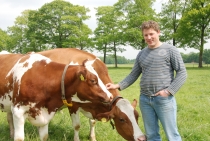
Dairy farmer Koen Bolscher works with N-xt Fertilizers on soil fertility.

Dairy farms need to know more about soil fertility. That is the firm conviction of Koen Bolscher. "After all, soil is our most expensive means of production." The dairy farmer from Bornerbroek in the Dutch province of Overijssel first found out about the fertilisation vision of N-xt Fertilizers via a fellow-farmer some years ago. He started basing his approach on it four years ago. The result speaks for itself: improved grass cover, a higher crop yield, better roughage quality and healthy cows that efficiently produce milk. "I can't say whether all of this is down to those liquid fertilisers", laughs Koen. "Either way, everything's going well."
What appealed to Koen about N-xt Fertilizers is that in essence they focus on remediating the soil rather than fertilising the crop. "If the physical, chemical and biological properties of the soil are right, that also guarantees that the crops contain sufficient nutrients", says Koen Bolscher. This was based on an analysis using the Kinsey-Albrecht method. "This analysis is different and more comprehensive than what I was used to. As well as this more comprehensive analysis method, at N-xt Fertilizers they use fertilisers that are good for the soil life rather than putting it under pressure. That definitely has its advantages, too."
17 tons of dry matter
The young dairy farmer runs the company with 200 red Holstein Frisians together with his parents. He is also an officer of the Dutch Young Farmers' Association (NAJK), and holds the Dairy Farming portfolio. In that capacity Bolscher speaks to many fellow-dairy farmers. He notices how little is known about soil fertility in the sector, despite the fact that this is what determines a large part of the business yield. "There's so much we don't know about it", says Koen. "If the conditions are optimal you can harvest as much as 17 tons of dry matter per hectare per year. But Dutch dairy farms don't get much further than 10 to 12 tons', he explains. "And there are big differences in silage quality. That clearly shows that there's plenty of room for improvement. Certainly when it comes to soil fertility."
Feeding with carbon
As well as an improved approach to the soil fertility aspect Koen has also been feeding his cows some carbon-clay minerals for a few years. He believes that this has a favourable effect on protein utilisation and also improves the manure quality. Koen: "This has also definitely contributed to improving the soil fertility. These days I see more earthworms and dung beetles. And manure piles have completely disappeared within five weeks, for example. That's a sign that there's plenty of activity in and on the soil." Choices such as these do of course call for investment. Koen is perfectly aware of that. "This is another area where the costs come before the benefits. But I'm certain that it brings about so much progress that the investments are justifiable", says the dairy farmer.
Greater feed efficiency
A number of aspects have visibly improved since the Bolscher family chose to follow the N-xt Fertilizers approach. The grass has become more dense and deeply rooted. That reduces weeds in the fields and the grass is less vulnerable to drought. The grass cover lasts considerably longer and a lot less pestice is needed. "There's also a higher dry matter yield and greater roughage efficiency", says Koen enthusiastically. “The cows are doing well. Production has gone up with the same amount of feed concentrate. All in all, this gives us the confidence that we are on the right track with the N-xt approach.








